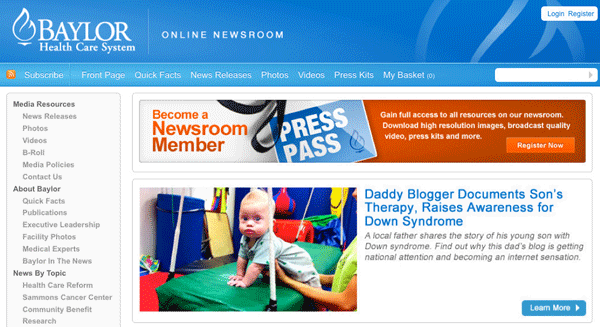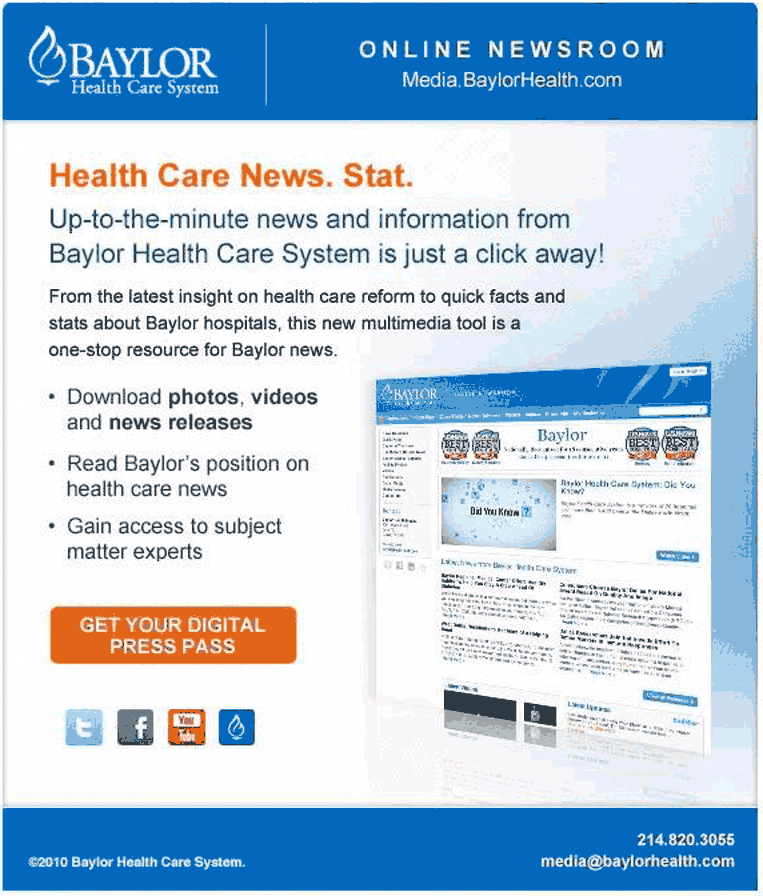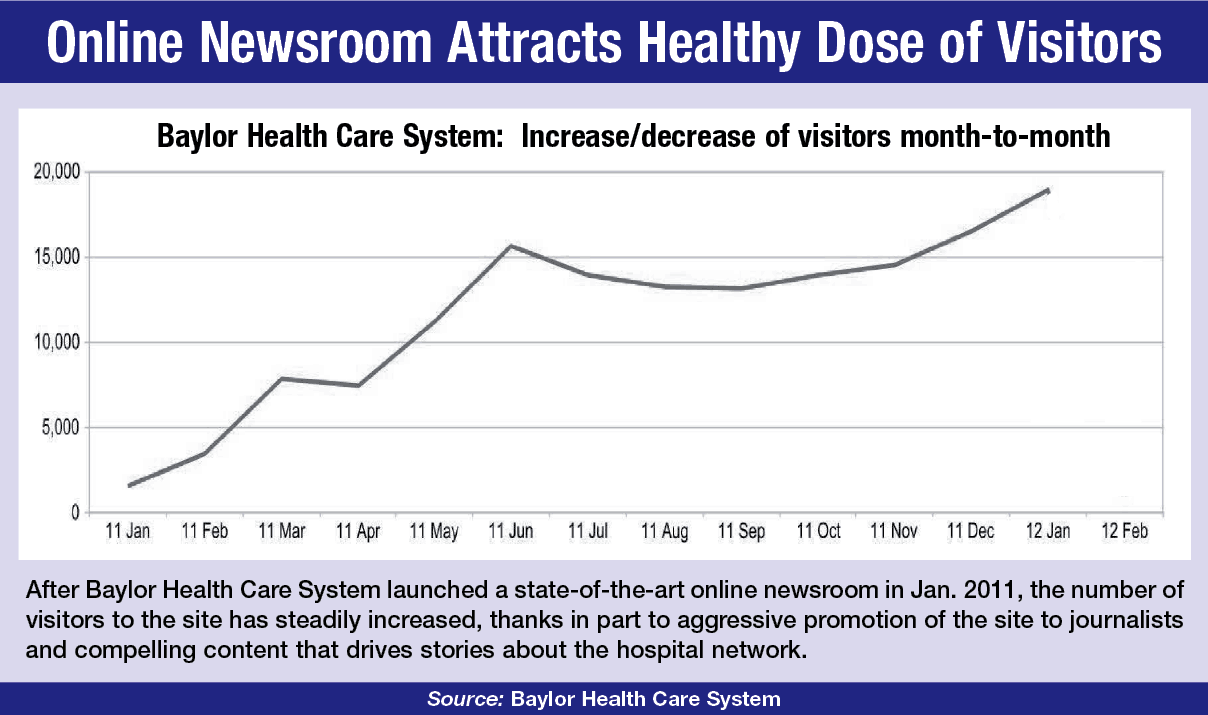 |
|
Baylor Health Care System’s online newsroom sports two standout features: required registrations for journalists to download content, and a “basket” content checkout system a la Amazon. Image courtesy of Baylor Healthcare Systems |
Company: Baylor Health Care System
Timeframe: Nov. 2009 - Jan. 2012
Journalists now get their information from a wide variety of sources, including Twitter, so you might be inclined to think “woe is the online newsroom.” Indeed, the idea of such a destination on an organization’s Web site now seems a bit quaint. Not so fast, however: A 2011 TekGroup International study found that 83% of journalists think it’s important for organizations to have online newsrooms to source information.
TIRED NEWSROOM
Unfortunately for Dallas-based Baylor Health Care System, an organization that offers a full range of medical services through 27 owned, leased or affiliated hospitals, its antiquated online newsroom wasn’t a destination reporters flocked to. Back in 2008, the BHCS newsroom (media.baylorhealth.com/) was bare-bones, says Nikki Mitchell, director of media relations. “It had old press releases and contact information,” she says. “We wanted something more robust.”
Interviews with health reporters that BHCS worked closely with indicated that they couldn’t find hospital statistics and other information they were looking for. “Because we were so large, reporters wanted to find out just who we were,” says Mitchell. “I thought if they can’t find online answers to such a simple question, we’re not doing our job.”
So BHCS began to consider a different tack for its newsroom: Why not make it not just a feed of press releases, but more of tool the media could use to enhance their jobs? The goal, says Mitchell, was to make the online newsroom user-friendly and easily accessible while offering relevant and timely content.
In November 2009, planning began for a new newsroom with the overall objectives of:
• Easily accessible facts and information, downloadable photos and videos.
• Elevating BHCS to one of the top five healthcare systems in the country. “We wanted to build something that would be on par with Cleveland Clinic and Mayo Clinic,” says Mitchell.
• At the same time, build a Web infrastructure that would enable optimal crisis preparedness. “We needed the capability to go in and quickly change information in the event of a crisis,” says Jennifer McDowell, senior media relations consultant at BHCS.
 |
| To promote the launch of its online newsroom, Baylor Health Care System created this ad and sent it to journalists in e-mails. |
To help them reach those goals, BHCS enlisted the help of Wieck Media, a Dallas-based agency that specializes in building and managing online newsrooms for clients such as Southwest Airlines and Allstate. “We sat down with Baylor and talked about their needs and what we were doing for our other clients,” says Tim Roberts, CEO of Wieck Media.
The planning was a matter of deciding what the newsroom site wasn’t going to be. “We weren’t trying to be WebMD,” says Mitchell. “It was just Baylor-oriented news.” Getting that news and information to the media quickly and efficiently was critical, says McDowell. But how? In a nutshell, make search for press releases, photos and video easy.
But easy access was part of the planning debate. Mitchell says they looked at newsrooms outside of the healthcare industry, paying particular attention to Ford, which has images of its facilities available for download. “There’s a possibility of a negative story made more powerful by a photo,” says Mitchell. Yet Ford has had success with making images available.
One of the features that drives that success is registration for journalists. Here is an explanation of the registration process on Ford’s Web site: “When registering as an accredited media user, you will be able to access high resolution photography and media contact lists within one business day.” BHCS decided to take a similar route. “We’re walking a fine line of being annoying but at the same time knowing who is on our site and what content they’re downloading,” says Mitchell.
With help from Wieck, BHCS designed the newsroom to include the following features:
â–¶ Quick Facts: a historical timeline of the organization and frequently updated facts such as bed counts, financial statistics, number of employees, etc.
â–¶ News Releases: A feed of the latest announcements in chronological order.
â–¶ Video library: A repository of every video produced in-house is filed here and users have the ability to clip and edit each segment as needed.
â–¶ Photo library: An archive of photos including Baylor events and facility renderings as well as head shots of experts and leadership.
â–¶ Press Kits: A library of press kits in digital form that can be downloaded in one file or in individual pieces as needed.
â–¶ Media Policies: A quick reference of all Baylor media policies is accessible through the home page to give media outlets a guide for information requests, hospital campus policies and reminders about patient privacy regulations.
â–¶ Baylor Media Experts: A list of Baylor experts who are featured on local news segments, with bios and head shots.
â–¶ Baylor in the News: An archive of news stories featuring Baylor experts organized in chronological order.
â–¶ Shopping Basket: Similar to online shopping, users can choose the items they wish to download (in multiple formats), put them in their basket and “check out” when they are finished.
In parallel to the newsroom work, Wieck made sure BHCS was ready to feed the media beast in a crisis, building a “dark site” for Baylor: sections of the main site based around different crisis scenarios—floods, fires, tornados, etc.—pre-stocked with content pertaining to those crises (see the sidebar for more on dark sites).
 |
WORKING THE ROOM
Six months after the launch—and just after the promo blitz to journalists—the site began to hum with media activity (see the chart for details). From Jan. 2011 to Jan. 2012, the online newsroom generated the following results:
• 153,406 visitors, an average of 10,957 visits a month;
• 1,139 hits a day from over 130 countries;
• 342 registered users; and
• 3,495 content downloads.
Thanks to a steady stream of compelling content posted on the newsroom, the amount of pitches to journalists has decreased. “We heard from reporters that they were tired of being pitched,” says McDowell. “So we let our content do the pitching—having reporters go in the newsroom and mine for stories themselves.”
The destination has also altered the BHCS press release strategy: They don’t send out the actual releases. “We e-mail a link to where press release and video materials reside in the newsroom,” says Mitchell. “Once we get reporters there, they are apt to search for more stories.”
Social media is becoming a bigger part of the newsroom equation, as Facebook and Twitter posts direct followers to the newsroom for more information.
Measurement also looms large for the newsroom. “Communicators are in the habit of pushing out content, but not looking at its effectiveness,” says Mitchell. “We look at what they’re reading, how often they’re on the site and what they are checking out in their baskets.”
Ah, baskets. In this case, score one for the BHCS online newsroom. PRN
[For more in-depth case studies, visit PR News’ Subscriber Resource Center: prnewsonline.com/subscriber_resources.html]
CONTACT:
Nikki Mitchell, [email protected]; Jennifer McDowell, [email protected]; Tim Roberts, [email protected].
Follow Scott Van Camp: @svancamp01
